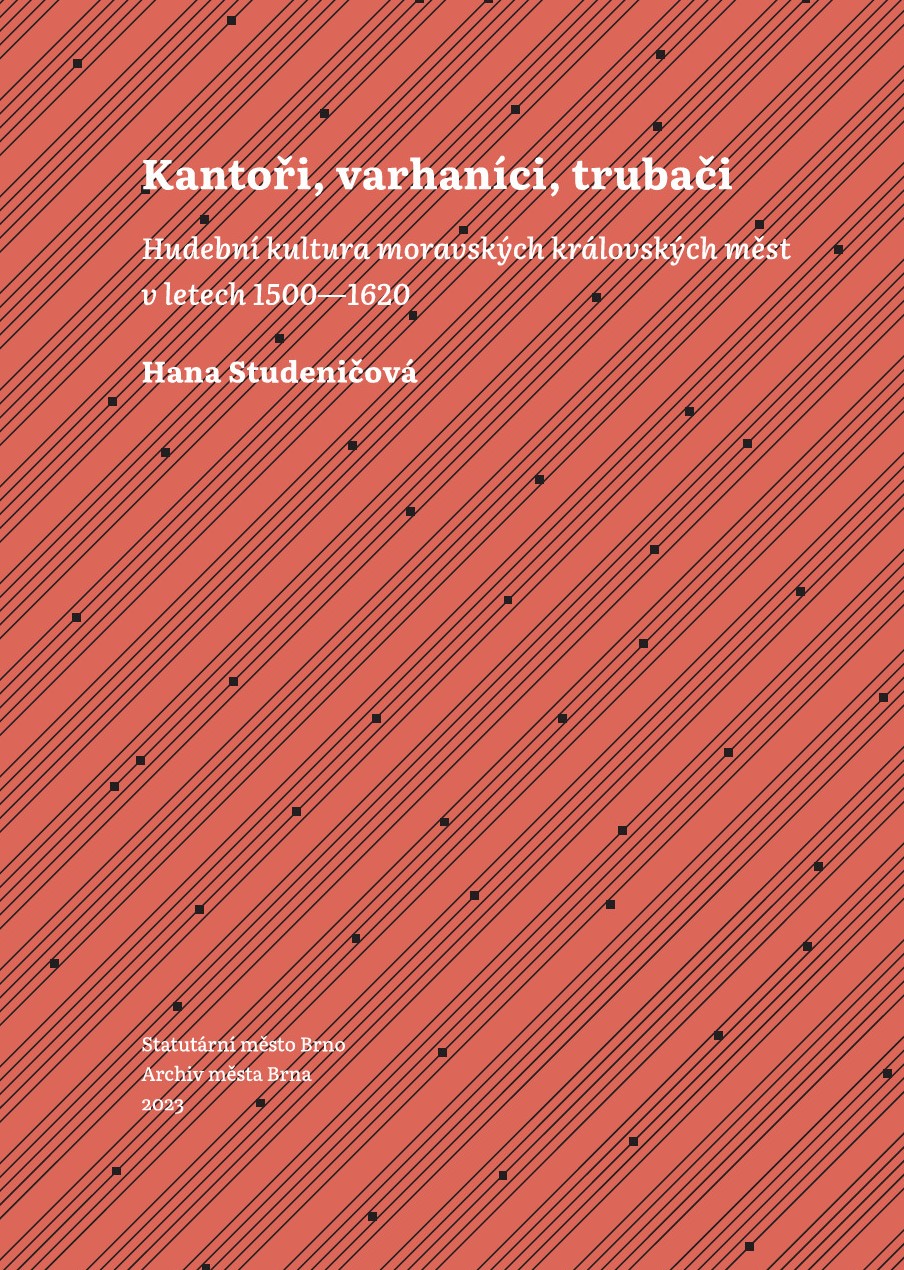 In Brno, Znojmo, Jihlava and Olomouc, the four most important Moravian royal towns in the 16th and 17th centuries, many political, social and religious events took place, of which music was an integral part. The cities in general were among the main centres of musical culture during the Renaissance. The richest musical tendencies can be seen in particular in the city parish churches. From these institutions, a rich array of archival sources has survived to this day, thanks to which it is possible to provide readers with answers to the key questions: who were the main musical figures of this period? Where and on what occasions was music usually heard in the cities, and what specific repertoire was performed during these events?
In Brno, Znojmo, Jihlava and Olomouc, the four most important Moravian royal towns in the 16th and 17th centuries, many political, social and religious events took place, of which music was an integral part. The cities in general were among the main centres of musical culture during the Renaissance. The richest musical tendencies can be seen in particular in the city parish churches. From these institutions, a rich array of archival sources has survived to this day, thanks to which it is possible to provide readers with answers to the key questions: who were the main musical figures of this period? Where and on what occasions was music usually heard in the cities, and what specific repertoire was performed during these events?
The Austrian Medieval Monastic Music Manuscripts Database
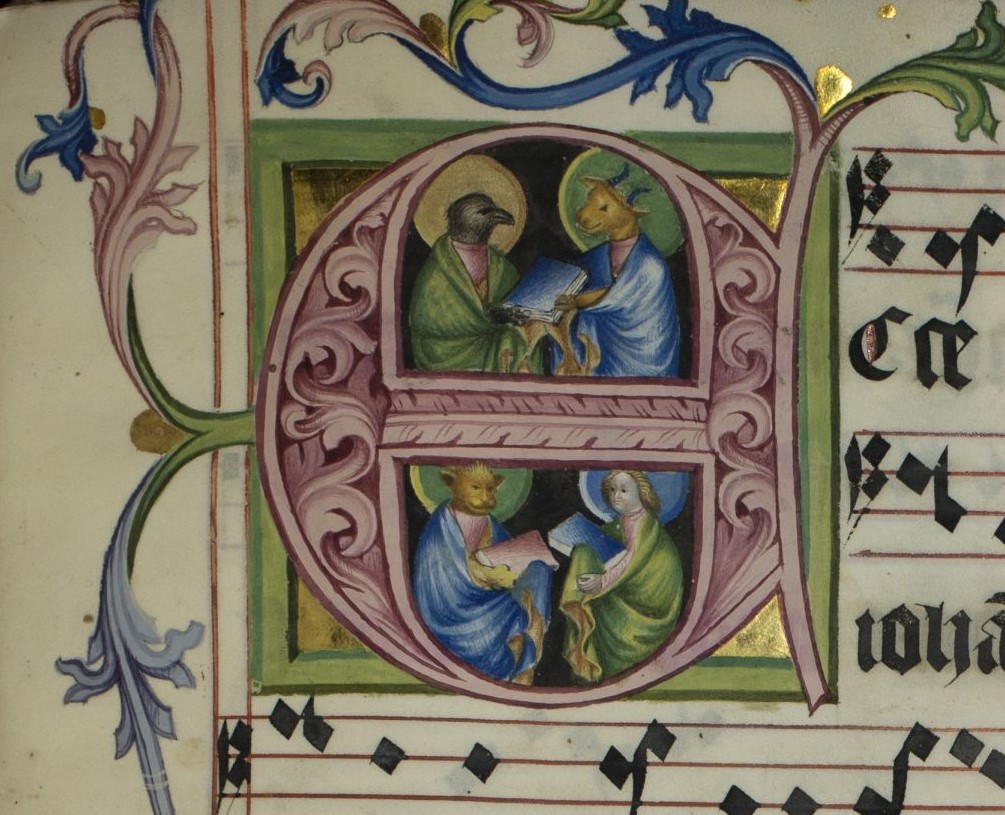 A subsidiary database has been created as part of the APVV and Mobility projects with the Augustinian Library in Klosterneuburg http://austriamanus.org, in which notated fragments used in their secondary function as “recycled” materials (maculature) on other manuscripts, prints, incunables or archival documents were processed. The database is linked to the global portal (network) of medieval notated sources http://cantusindex.org. Doctoral and postdoctoral researchers of the Institute have taken an active part in data import (H. Studeničová, E. Lazorík, V. Garajová).
A subsidiary database has been created as part of the APVV and Mobility projects with the Augustinian Library in Klosterneuburg http://austriamanus.org, in which notated fragments used in their secondary function as “recycled” materials (maculature) on other manuscripts, prints, incunables or archival documents were processed. The database is linked to the global portal (network) of medieval notated sources http://cantusindex.org. Doctoral and postdoctoral researchers of the Institute have taken an active part in data import (H. Studeničová, E. Lazorík, V. Garajová).
VESELOVSKÁ, Eva (Ed.). The Image of Piety in Medieval Manuscripts in Slovakia and in Europe
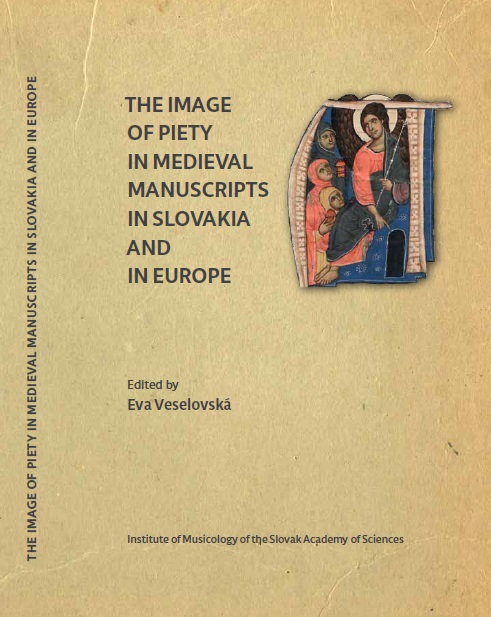 The conference proceeding THE IMAGE OF PIETY IN MEDIEVAL MANUSCRIPTS IN SLOVAKIA AND IN EUROPE contains seven interdisciplinary contributions. The papers focus on medieval materials, specific manuscripts, and epigraphic sources, their contents, creators, and fates in various socio-cultural milieus (urban centres, ecclesiastical institutions, individuals). The papers map the pieces of knowledge about medieval piety through concrete examples. Three studies from the field of epigraphy, codicology – palaeography, and diplomatics deal with specific topics of the image of piety on the examples of epigraphic sources from the territory of Slovakia (J. Šedivý, R. Luz) and from medieval Transylvania (A. Papahagi). The musicological papers focus on piety from the aspect of a targeted analysis of the selected musical repertoire of a complete musical source, the Scandinavian Missal Ms. 387 from the Central Library of the Slovak Academy of Sciences (R. Adamko – J. Bednáriková – Z. Zahradníková). The comparative processing and evaluation of fragmentarily surviving materials form the focus of three musicological studies (Z. Czagány, G. Gilányi, E. Veselovská – J. Bednáriková).
The scientific evaluation of the processes of the genesis and use of medieval materials revealed a specific force of the distribution of transregional elements on the one hand and an ability to maintain the local elements of piety in the examined localities on the other hand.
The conference proceeding THE IMAGE OF PIETY IN MEDIEVAL MANUSCRIPTS IN SLOVAKIA AND IN EUROPE contains seven interdisciplinary contributions. The papers focus on medieval materials, specific manuscripts, and epigraphic sources, their contents, creators, and fates in various socio-cultural milieus (urban centres, ecclesiastical institutions, individuals). The papers map the pieces of knowledge about medieval piety through concrete examples. Three studies from the field of epigraphy, codicology – palaeography, and diplomatics deal with specific topics of the image of piety on the examples of epigraphic sources from the territory of Slovakia (J. Šedivý, R. Luz) and from medieval Transylvania (A. Papahagi). The musicological papers focus on piety from the aspect of a targeted analysis of the selected musical repertoire of a complete musical source, the Scandinavian Missal Ms. 387 from the Central Library of the Slovak Academy of Sciences (R. Adamko – J. Bednáriková – Z. Zahradníková). The comparative processing and evaluation of fragmentarily surviving materials form the focus of three musicological studies (Z. Czagány, G. Gilányi, E. Veselovská – J. Bednáriková).
The scientific evaluation of the processes of the genesis and use of medieval materials revealed a specific force of the distribution of transregional elements on the one hand and an ability to maintain the local elements of piety in the examined localities on the other hand.
ADAMKO, Rastislav – BEDNÁRIKOVÁ, Janka – LUZ, Rastislav – SÝKORA, Adam – VESELOVSKÁ, Eva – ZAHRADNÍKOVÁ, Zuzana. Missale Notatum Lundense Pars Aestivalis : Results of Previous Research on the Source and Facsimilies. Rastislav Adamko (ed.)
 The longstanding processing of a unique manuscript from Scandinavia, now deposited in Slovakia, has resulted in its source edition published as a multi-authored monograph by the German publisher Peter Lang. The Missale Notatum Lundense Pars Aestivalis : Results of Previous Research on the Source and Facsimiles (ed. R. Adamko) publication provides access for the specialized and the lay public to this unique medieval musical manuscript dating back to the turn of the thirteenth and the fourteenth centuries, which is now deposited in the Central Library of the Slovak Academy of Sciences. Missal Ms. 387 is the only musical liturgical manuscript from the medieval period from Scandinavia which has survived in its complete form. It documents the liturgical tradition of the Diocese of Lund (present-day Sweden; the diocese was established in 1048 as part of the Kingdom of Denmark). The monograph contains the facsimile edition of the source along with interdisciplinary studies by a team of authors (Rastislav Adamko, Janka Bednáriková, Rastislav Luz, Adam Sýkora, Eva Veselovská, Zuzana Zahradníková), which deal with the codex from the aspect of musicology, codicology, palaeography, liturgics, and general history.
The longstanding processing of a unique manuscript from Scandinavia, now deposited in Slovakia, has resulted in its source edition published as a multi-authored monograph by the German publisher Peter Lang. The Missale Notatum Lundense Pars Aestivalis : Results of Previous Research on the Source and Facsimiles (ed. R. Adamko) publication provides access for the specialized and the lay public to this unique medieval musical manuscript dating back to the turn of the thirteenth and the fourteenth centuries, which is now deposited in the Central Library of the Slovak Academy of Sciences. Missal Ms. 387 is the only musical liturgical manuscript from the medieval period from Scandinavia which has survived in its complete form. It documents the liturgical tradition of the Diocese of Lund (present-day Sweden; the diocese was established in 1048 as part of the Kingdom of Denmark). The monograph contains the facsimile edition of the source along with interdisciplinary studies by a team of authors (Rastislav Adamko, Janka Bednáriková, Rastislav Luz, Adam Sýkora, Eva Veselovská, Zuzana Zahradníková), which deal with the codex from the aspect of musicology, codicology, palaeography, liturgics, and general history.
VESELOVSKÁ, Eva – LAZORÍK, Eduard. Catalogus fragmentorum medii aevi – Archivum Civitatis Cassoviensis
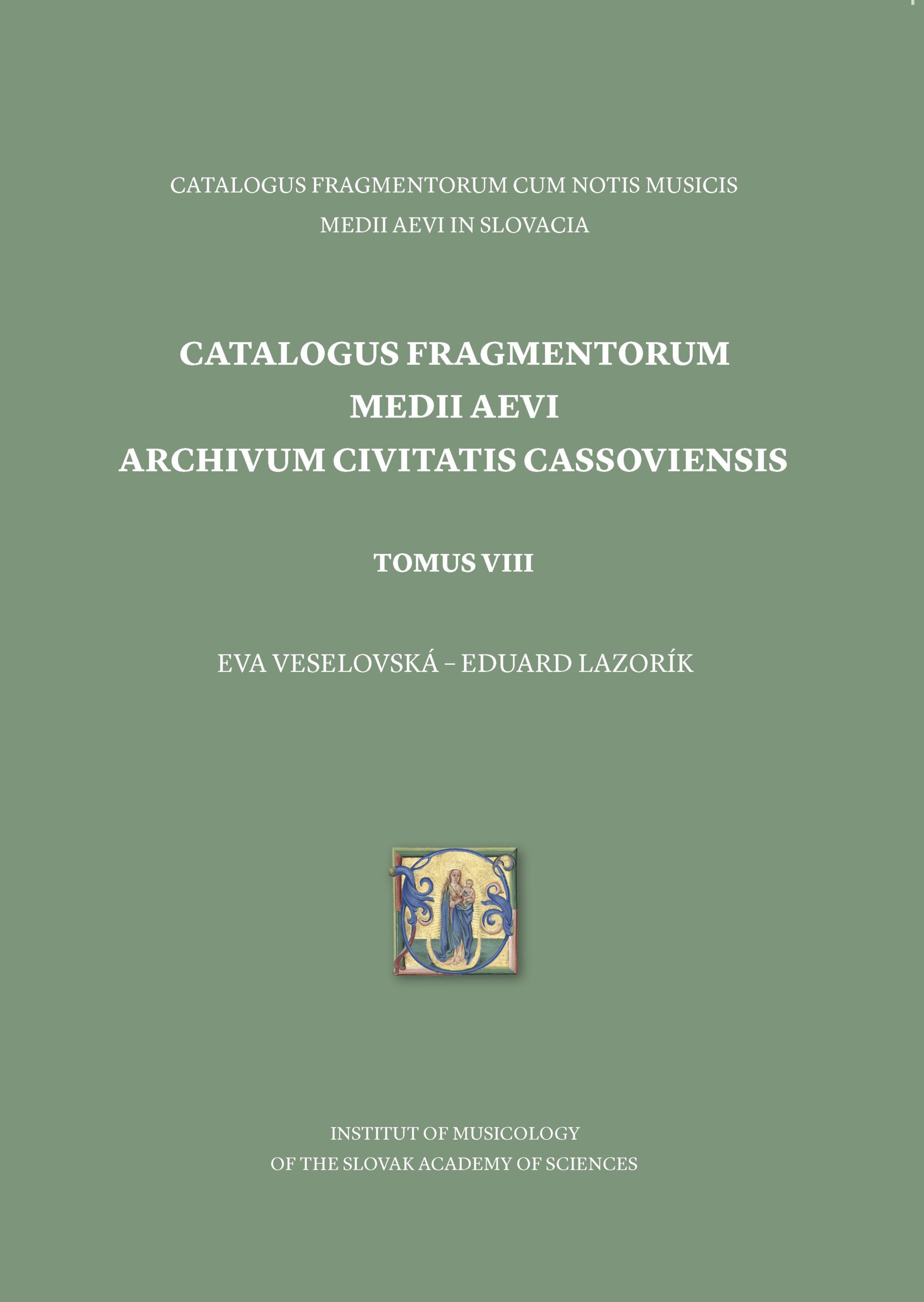 Volume Eight, Catalogus fragmentorum medii aevi – Archivum Civitatis Cassoviensis, of the Catalogus fragmentorum cum notis musicis medii aevi in Slovacia series provides access to the earliest, medieval sources of the Košice City Archives.
Medieval parchments formed the binding of various administrative documents from the municipality of Košice. In the Košice City Archives, these valuable manuscripts survive from the late thirteenth century to the early sixteenth century. The Košice volume of the Catalogus fragmentorum etc. series makes forty-two medieval fragments available, processed in the form of scientific studies (split into notated and non-notated fragments) and two separate catalogues in Latin and English. Both catalogues include registers (by type of notation, type of manuscript, assumed provenance, script, dating, and incipit). Most of the medieval music presumably originated in scriptoria in the territory of present-day Slovakia, Hungary, or Romania (medieval Hungary: mainly Spiš, Šariš, and Transylvania). It is an extremely compact collection, where several groups of fragments which originally formed part of the same codex have been identified.
Volume Eight, Catalogus fragmentorum medii aevi – Archivum Civitatis Cassoviensis, of the Catalogus fragmentorum cum notis musicis medii aevi in Slovacia series provides access to the earliest, medieval sources of the Košice City Archives.
Medieval parchments formed the binding of various administrative documents from the municipality of Košice. In the Košice City Archives, these valuable manuscripts survive from the late thirteenth century to the early sixteenth century. The Košice volume of the Catalogus fragmentorum etc. series makes forty-two medieval fragments available, processed in the form of scientific studies (split into notated and non-notated fragments) and two separate catalogues in Latin and English. Both catalogues include registers (by type of notation, type of manuscript, assumed provenance, script, dating, and incipit). Most of the medieval music presumably originated in scriptoria in the territory of present-day Slovakia, Hungary, or Romania (medieval Hungary: mainly Spiš, Šariš, and Transylvania). It is an extremely compact collection, where several groups of fragments which originally formed part of the same codex have been identified.
VESELOVSKÁ, Eva – BEDNÁRIKOVÁ, Janka – LAZORÍK, Eduard. Catalogus fragmentorum medii aevi ex castello Betliar : Mittelalterliche Fragmente aus Betler (Betliar)
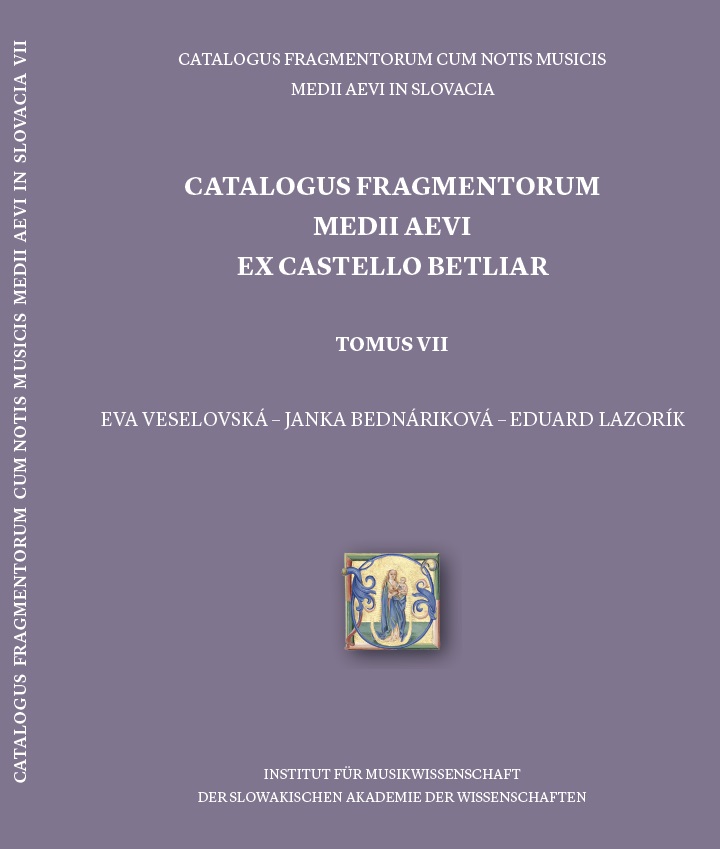 Volume Seven of the Catalogus fragmentorum cum notis musicis medii aevi in Slovacia series provides access to the oldest materials of the Slovak National Museum – Betliar Museum. Eighteen notated and twelve (plus two) non-notated parchment bindings from the twelfth to the fifteenth centuries have survived in the bindings of books in the Library of the Betliar Mansion. Manuscripts of various contents and provenance were used as the upper cover of younger books. All the notated sources document monophonic liturgical chant, the so-called cantus planus, or plainchant. This is the first time within these series that notated and non-notated fragments have been processed together. The palaeographical and contentual (liturgical and musicological) analysis of the fragments has revealed either the transfer of musical codices from the place of their origin and use (manuscripts from Bohemia, Germany, and Poland) or the local specificities of Hungarian scriptoria (manuscripts from Spiš).
Volume Seven of the Catalogus fragmentorum cum notis musicis medii aevi in Slovacia series provides access to the oldest materials of the Slovak National Museum – Betliar Museum. Eighteen notated and twelve (plus two) non-notated parchment bindings from the twelfth to the fifteenth centuries have survived in the bindings of books in the Library of the Betliar Mansion. Manuscripts of various contents and provenance were used as the upper cover of younger books. All the notated sources document monophonic liturgical chant, the so-called cantus planus, or plainchant. This is the first time within these series that notated and non-notated fragments have been processed together. The palaeographical and contentual (liturgical and musicological) analysis of the fragments has revealed either the transfer of musical codices from the place of their origin and use (manuscripts from Bohemia, Germany, and Poland) or the local specificities of Hungarian scriptoria (manuscripts from Spiš).
Eva Veselovská – Zsuzsa Czagány (eds): Notated Sources from Medieval Europe and Medieval Hungary
 The publication was prepared as conference book of the homonymous scientific workshop held in Bratislava on 24 October 2017 within the frame of the bilateral project of international cooperation between the Slovak Academy of Sciences and the Hungarian Academy of Sciences. The goal of the publication is a presentation of part of updated results of research on medieval musical culture in Central Europe, with the aim of supporting a coordinated and systematic international research. The publication includes articles from 4 countries (Slovenia, Hungary, Czech Republic, and Slovakia) focusing on the oldest fragmentarily preserved materials from Bohemia (Jana Vozková), from Slovenia (Jurij Snoj), and from Slovakia (Janka Bednáriková), transregional identified fragments (Zsusza Czagány, Gabriella Gilányi), specific contents (Rastislav Adamko, Eva Veselovská, Rastislav Luz), and Modern Age sources based on medieval liturgical tradition (Ágnes Papp).
The publication was prepared as conference book of the homonymous scientific workshop held in Bratislava on 24 October 2017 within the frame of the bilateral project of international cooperation between the Slovak Academy of Sciences and the Hungarian Academy of Sciences. The goal of the publication is a presentation of part of updated results of research on medieval musical culture in Central Europe, with the aim of supporting a coordinated and systematic international research. The publication includes articles from 4 countries (Slovenia, Hungary, Czech Republic, and Slovakia) focusing on the oldest fragmentarily preserved materials from Bohemia (Jana Vozková), from Slovenia (Jurij Snoj), and from Slovakia (Janka Bednáriková), transregional identified fragments (Zsusza Czagány, Gabriella Gilányi), specific contents (Rastislav Adamko, Eva Veselovská, Rastislav Luz), and Modern Age sources based on medieval liturgical tradition (Ágnes Papp).
Veronika Garajová: Catalogus fragmentorum cum notis musicis medii aevi e civitate Trenchini
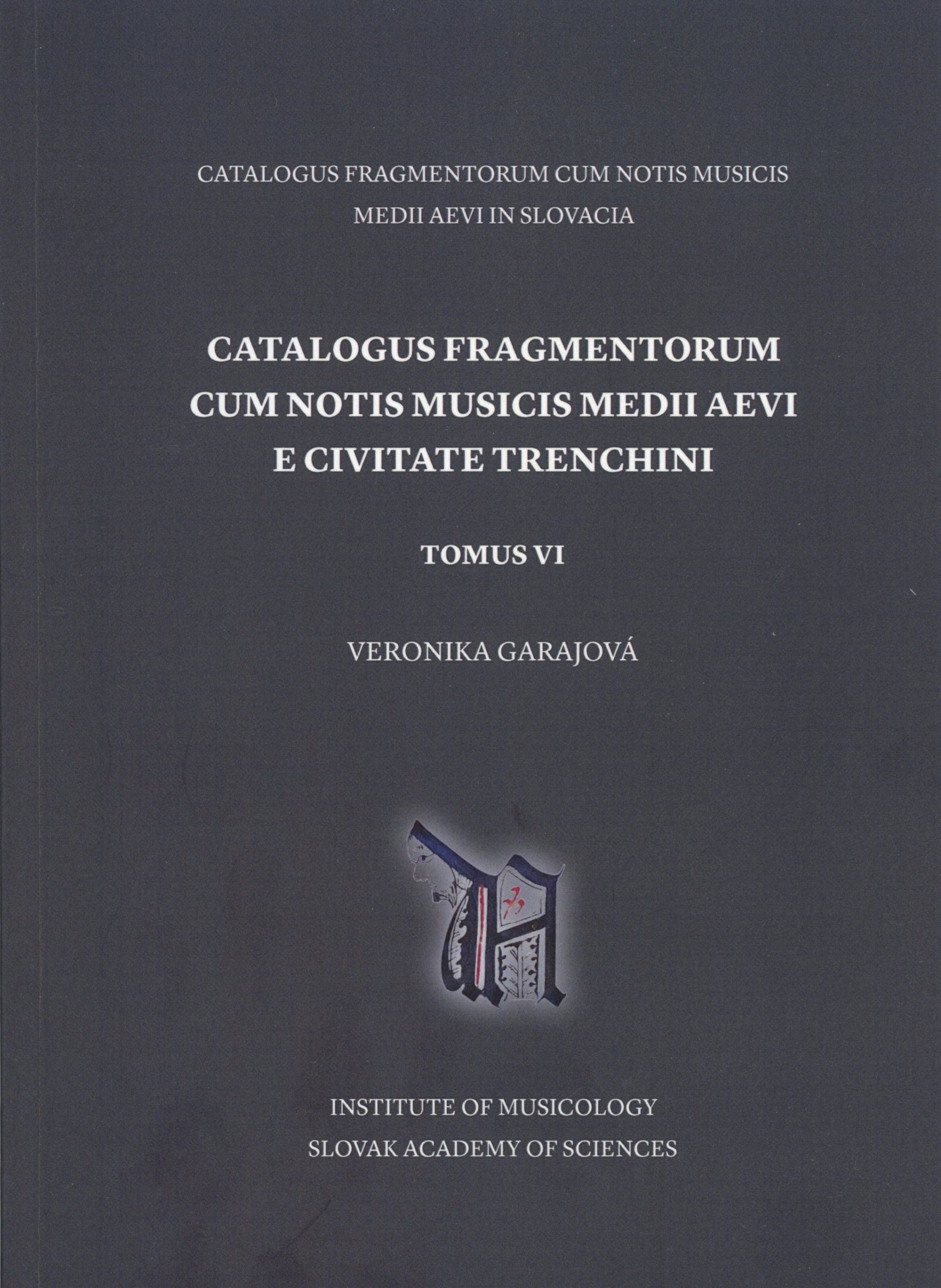 The publication Catalogus fragmentorum cum notis musicis medii aevi e civitate Trenchini updated knowledge of interdisciplinary researches on the oldest sources of musical culture in the territory of Slovakia. The monograph is the sixth volume of the Catalogus fragmentorum cum notis musicis medii aevi in Slovacia edition, published by the Institute of Musicology of the Slovak Academy of Sciences since 2008.
The work is in English language. It treats the medieval fragments from the State Archive of Trenčín – preserved as upper bindings of municipal protocols. The publication contains a detailed analysis and evaluation of precious liturgical manuscripts from the 14th century up to the beginning of the 16th century (11 antiphonaries, 8 graduals, 1 breviary, and 1 missal). The sources are processed as complex interdisciplinary studies (historical assumptions, codicological-palaeographical analysis, musical-palaeographical analysis, musical-liturgical analysis) integrated by a catalogue of manuscripts in Latin language. All preserved materials witness the musical heritage of liturgical chant – cantus planus.
The publication Catalogus fragmentorum cum notis musicis medii aevi e civitate Trenchini updated knowledge of interdisciplinary researches on the oldest sources of musical culture in the territory of Slovakia. The monograph is the sixth volume of the Catalogus fragmentorum cum notis musicis medii aevi in Slovacia edition, published by the Institute of Musicology of the Slovak Academy of Sciences since 2008.
The work is in English language. It treats the medieval fragments from the State Archive of Trenčín – preserved as upper bindings of municipal protocols. The publication contains a detailed analysis and evaluation of precious liturgical manuscripts from the 14th century up to the beginning of the 16th century (11 antiphonaries, 8 graduals, 1 breviary, and 1 missal). The sources are processed as complex interdisciplinary studies (historical assumptions, codicological-palaeographical analysis, musical-palaeographical analysis, musical-liturgical analysis) integrated by a catalogue of manuscripts in Latin language. All preserved materials witness the musical heritage of liturgical chant – cantus planus.
Soňa Burlasová: Chapters on the Slovak Folk Song
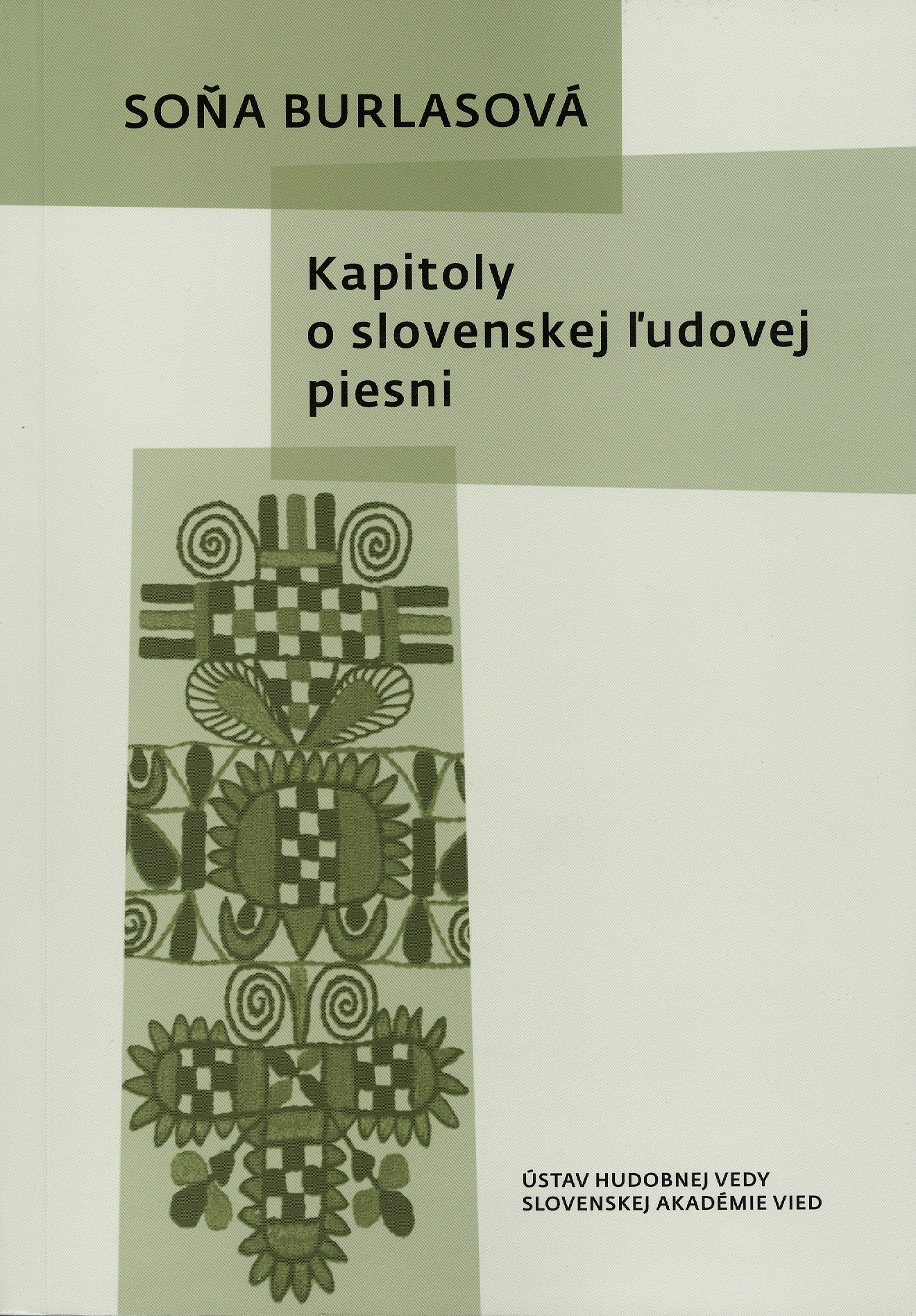 The aim of the publication is to present the contribution of ethnomusicologist and folklorist Soňa Burlasová (b. 1927) to the research of Slovak folk singing in a form of representative selection of her articles. The publication consists from 14 studies which map basic research orientation of this author from the view of research themes, methodology and chronology. Studies are ranked in six blocks (song genres, regional styles, ethnic minorities and folk singing, bearers of tradition and the role of a personality, new song creation, folk song in interethnic context). Publication contains studies originated in the period 1964 – 1990. Hana Urbancová, as the editor of publication, compiled articles being published in various journals and volumes in Slovakia and abroad, to one comprehensive monograph.
The aim of the publication is to present the contribution of ethnomusicologist and folklorist Soňa Burlasová (b. 1927) to the research of Slovak folk singing in a form of representative selection of her articles. The publication consists from 14 studies which map basic research orientation of this author from the view of research themes, methodology and chronology. Studies are ranked in six blocks (song genres, regional styles, ethnic minorities and folk singing, bearers of tradition and the role of a personality, new song creation, folk song in interethnic context). Publication contains studies originated in the period 1964 – 1990. Hana Urbancová, as the editor of publication, compiled articles being published in various journals and volumes in Slovakia and abroad, to one comprehensive monograph.
Jana Lengová: Stephanie Wurmbrand-Stuppach (1849−1919) : Life, Work, Correspondence
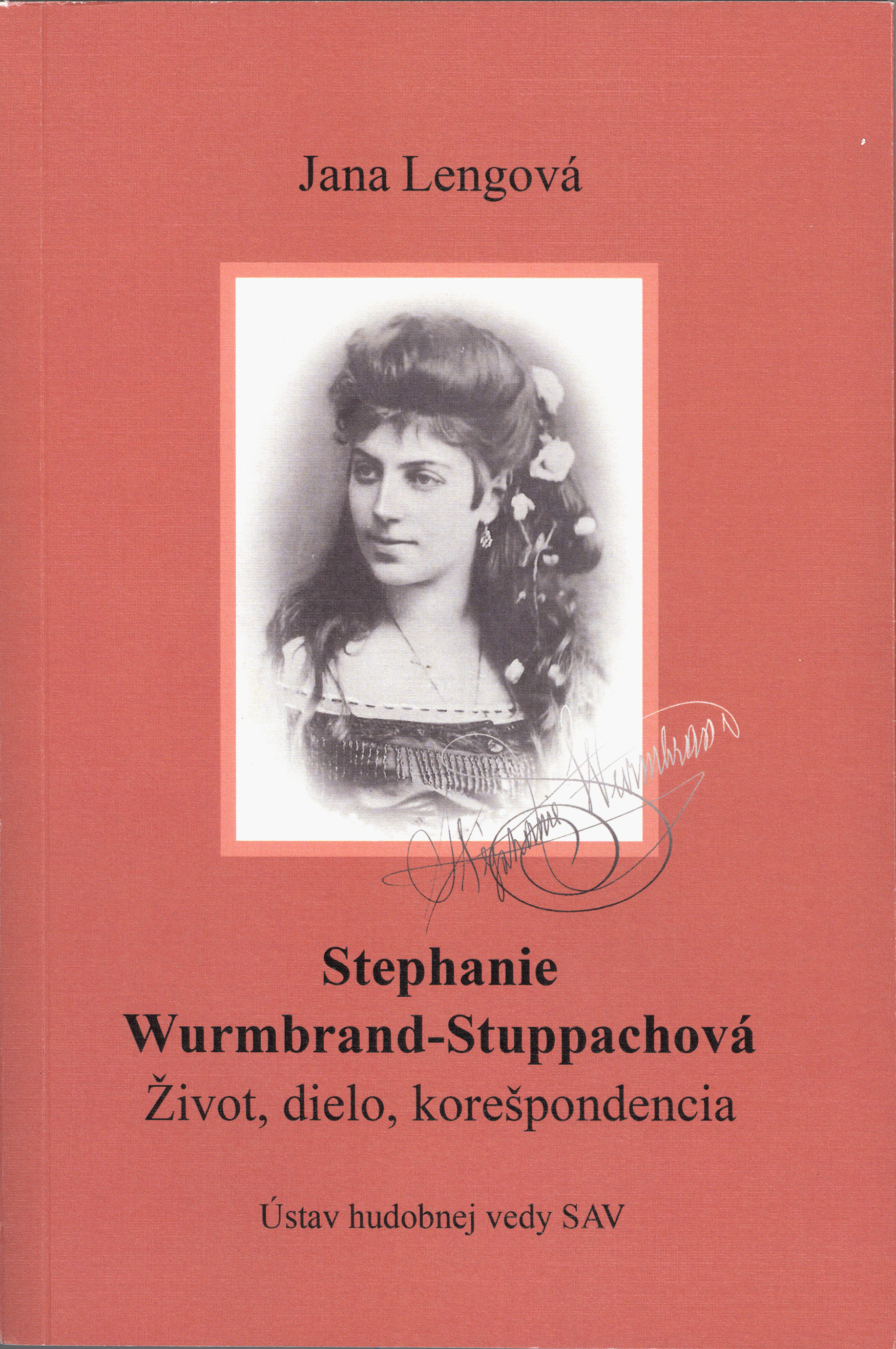 The scholarly biography of the pianist, composer and writer Stephanie Wurmbrand-Stuppach, born Vrabély, resulted from the long-lasting source research. It is the first book monograph covering life and work of little known exponent of the Slovak and Central-European history of music of the second half of the 19th century. It brings rich new information regarding her biography, exhaustive stylistic and semantic analysis and fresh evaluation of the musical and literary work of the artist, including the transcription of part of preserved correspondence, as well as a register of her musical and literary work with a reference regarding their deposition. Musical and semantic context of her work is presented in a revealing way on the background of autobiographical elements and extra-musical stimuli. The composer’s creative focus and position in the society have been examined also from the aspect of gender and with the respect to period social conventions and lifestyle of the bourgeoisie and nobility. Due to its complex approach, explication and processing of the subject the monograph represents a significant contribution to the cognition of personalities of musical culture.
The scholarly biography of the pianist, composer and writer Stephanie Wurmbrand-Stuppach, born Vrabély, resulted from the long-lasting source research. It is the first book monograph covering life and work of little known exponent of the Slovak and Central-European history of music of the second half of the 19th century. It brings rich new information regarding her biography, exhaustive stylistic and semantic analysis and fresh evaluation of the musical and literary work of the artist, including the transcription of part of preserved correspondence, as well as a register of her musical and literary work with a reference regarding their deposition. Musical and semantic context of her work is presented in a revealing way on the background of autobiographical elements and extra-musical stimuli. The composer’s creative focus and position in the society have been examined also from the aspect of gender and with the respect to period social conventions and lifestyle of the bourgeoisie and nobility. Due to its complex approach, explication and processing of the subject the monograph represents a significant contribution to the cognition of personalities of musical culture.


